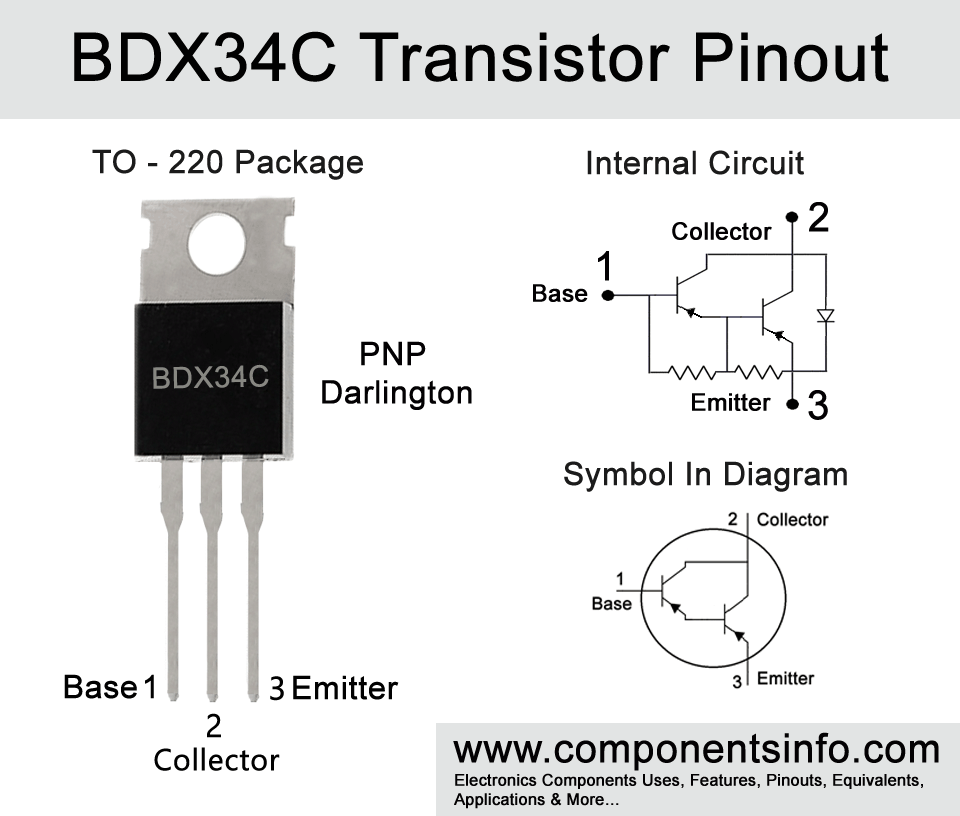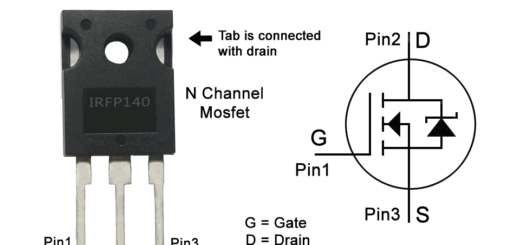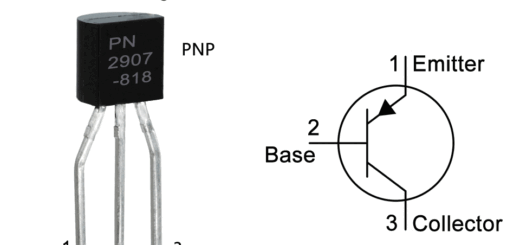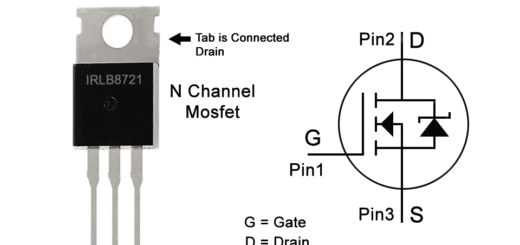BDX34C Transistor Pinout, Equivalent, Applications, Features and More
If you are looking for a better PNP general purpose Darlington transistor that can drive upto -10A then you should take a look at the BDX34C power transistor. In this article we will discuss BDX34C transistor pinout, equivalent, applications, features, where and how to use and other details.
Absolute Maximum Ratings:
- Package Type: TO-220
- Transistor Type: PNP Darlington
- Max Collector Current(IC): -10A
- Max Collector-Emitter Voltage (VCEO): -100V
- Max Collector-Base Voltage (VCBO): -100V
- Max Emitter-Base Voltage (VEBO): -5V
- Max Continuous Base Current: -0.25A
- Max Collector Power Dissipation (Pc): 70 Watt
- Minimum DC Current Gain (hFE): 750
- Max Storage & Operating temperature: -65 to +150 Centigrade
NPN Complementary:
NPN Complementary of BDX34C is BDX33C
Replacement and Equivalent:
NTE2344, MJF6668, BDX34D, BDX94C, BDW48, BDW47, BDT62B
BDX34C Transistor Explained / Description:
BDX34C is a high gain Darlington transistor available in TO-220 package. The transistor is designed for general purpose switching and amplifier applications but can also be used in wide variety of other general purpose uses.
Looking at the pin configuration of the transistor, when looking from the part number side or front the first pin of the transistor is “Base” sending pin is “Collector” that is also connected with the mounting base of the transistor and the third pin is “Emitter”.
BDX34C is also available in three other versions according to its collector-emitter and collector-base voltage, which can be determined by the part number such as the BDX34 collector-emitter and collector-base voltage is -45V, BDX34A has -60V and BDX34B has -80V. All of these transistors can easily be replaced by each other if your load voltage requirements are under their collector-emitter voltage limits.
Now looking at the absolute maximum ratings of the transistor the max collector-emitter voltage of the transistor is -100V, the maximum collector-base voltage is also -100V, max collector current is -10A, max continuous base current is -0.25A and max collector power dissipation is 70W.
Where We Can Use it & How to Use:
As we have already mentioned above that BDX34C is designed to use in general purpose switching and amplification applications but it is not limited to these uses and can also be used in many different types of general purpose applications that comes under its ratings.
For using the transistor either you want to use it as a switch or amplifier first of all check it pinout. Then for using as a switch connect its emitter pin with the positive rail of the circuit, its base with the signal from which you want to drive the transistor its collector with the positive wire of the load and the negative wire of the load will be connected with the negative rail of the circuit. For using the transistor as an amplifier the connection will be same but you have to use some passive components in the circuit according to your requirement such as a resistor that will be connected from the base to ground and base to positive rail, and a resistor between emitter and positive rail and also between collector and ground and also some filter capacitors.
Applications:
Voltage Regulation
Pulse Generator
Switching Circuits
Motor Control
LED Drivers
Audio Amplifiers
Voltage inverters
DC to DC Converters
Battery Operated Applications
Safe Operating Guidelines:
Here are the operating guidelines of the transistor.
- For safe operating it is important to not use the transistor to its absolute maximum ratings and always stay 20% below from these ratings.
- So according to this rule the maximum continuous current is -10A but we will only use -8A by driving the load only upto -8A.
- Now for load voltage (collector-emitter voltage), the maximum limit is -100V but we will not drive load of more than 80V.
- The operating temperature of the transistor or its surroundings should be between -55°C to 150°C.
Datasheet:
To download the datasheet just copy and paste the below link in your browser.
https://datasheetspdf.com/pdf-down/B/D/X/BDX34C_FairchildSemiconductor.pdf



